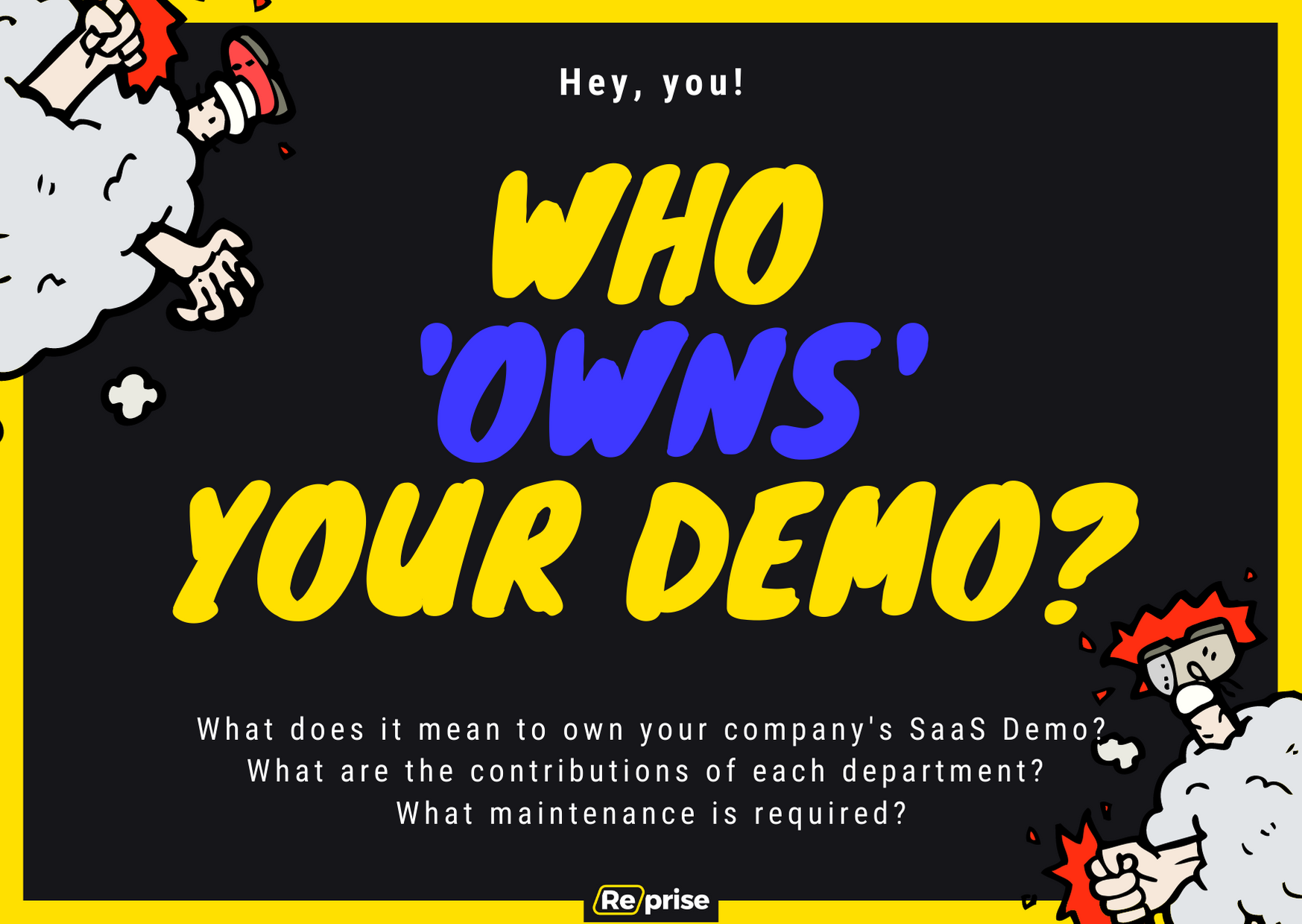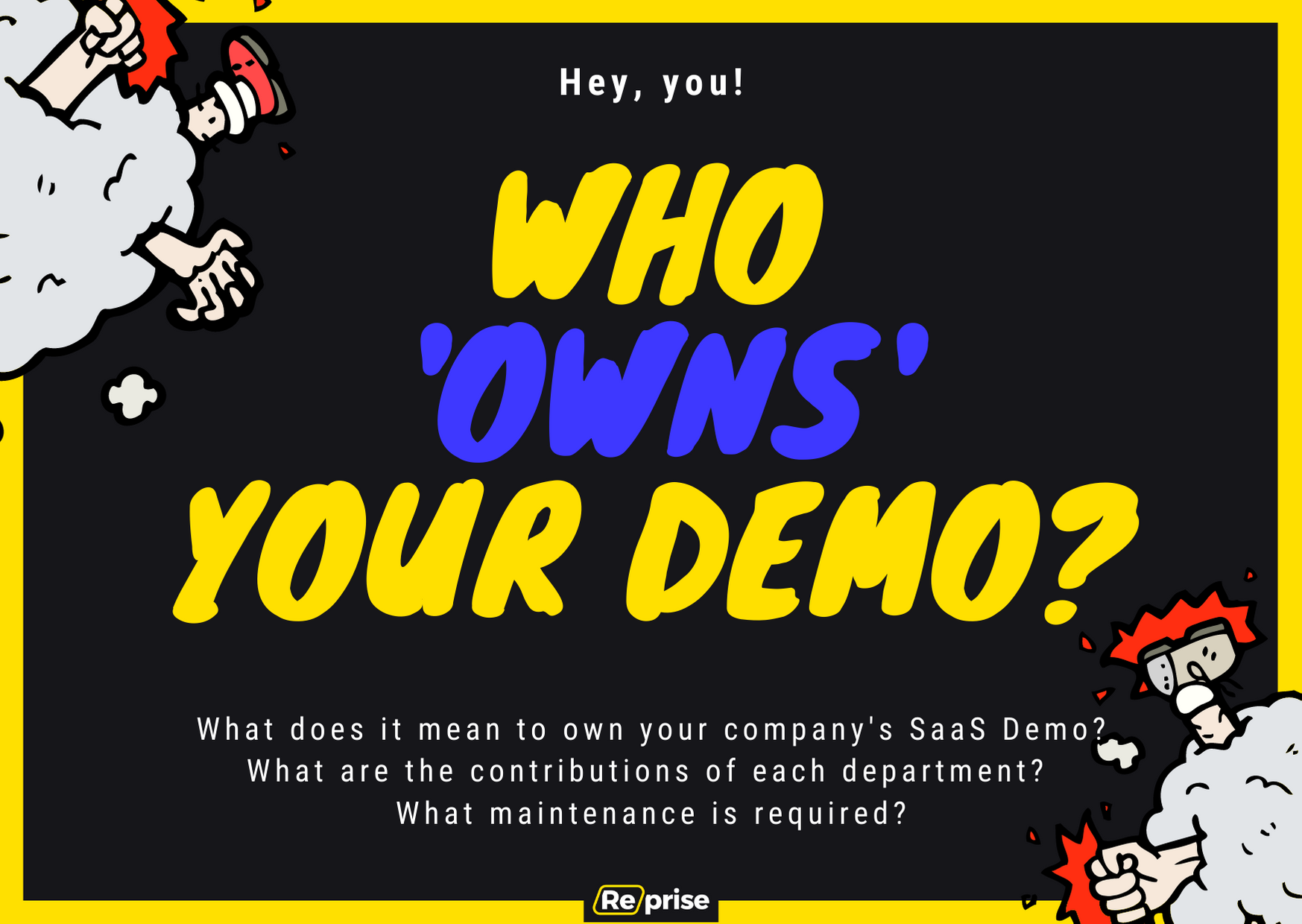Accelerate deals and increase win rates with the leading enterprise demo platform.
Nobody Owns your Demo – and Why That’s a Problem

February 10, 2025
Table of Contents
Nobody owns your demo.
Sure, you have a demo. And someone built it. Maybe someone even scripted a talk track or built a PowerPoint deck too. I mean, your demo exists… but does anyone actually own it?
Lack of ownership in your demo leads to inconsistent talk tracks and a bad buyer experience, which of course leads to lower win rates and lost revenue. It also makes for misaligned expectations with your prospects, with repercussions that extend well beyond lost deals. Specifically: churn and brand damage.
What’s broken? Well, everyone I’ve met assumes that someone else is on it, so in the end, nobody owns it.
As a friend of mine in Product Marketing put it:
“Nobody wants to own the demo. It’s thankless!”
But just because it’s a complicated, shared responsibility does not mean that leaving it up in the air is acceptable. The largest and most mature enterprise companies assign true ownership of their demo, and the time is long overdue for small and mid-sized companies to get the memo.
What It Means to Own the Demo
Before we get to who you should assign, let’s talk about what it means to own the demo.
Your first thought might be, “Oh, so and so wrote our demo.” But that’s not enough. Our discussion made it clear: owning the demo is not just about deciding what we show and tell prospects. It involves everything, including:
- Setting or aligning to your GoToMarket Motion – are you going to be a freemium experience or will you run the enterprise sales play? You’ve got to right-size your demo to the chosen selling motion.
- Crowdsourcing each department’s contributions. (More about this below.)
- Scripting click and talk tracks – including by segment, role, use case, and so on. These should be available to all and kept up to date.
- Building the actual, physical demo asset – this might include a single sandbox of anonymous data, or could involve building hundreds of real, production environments for your individual sellers to use.
- Equipping your teams with the proper collateral; both in product and outside (slideware, etc.) This needs to be done by segment; by whichever persona, firmographic, and use case segments exist in your org.
- Training and enforcing adoption from sales – in more mature orgs, it will include certifications and testing.
- Maintaining the demo and incorporating new releases – more labor intensive than the actual build for most orgs.
- Testing and iterating to improve conversion rates and effectiveness with customers.
Owning the demo is a real responsibility. That means it should be in the person’s job description, with a detailed list of responsibilities and how frequently key tasks should be performed. If your demo owner has a variable compensation plan, establish key metrics or objectives and tie a portion of their comp to this.
In short: it should be a major component of how this person’s success is measured.
How to Determine Who Should Own Your Demo
So, who should own your demo?
Ask a hundred people, get a hundred answers. No, literally. I did this and the market is all over the place on this one. Here’s my first pass at synthesizing the ‘rules of the road.’
1. It takes a village (every department owes something)
One person or small team must own the demo, but everyone owes something to it.
Assigning ownership of your demo does not mean that everyone else can now sit on their hands and not get involved. The person who owns the process simply takes overall responsibility for assimilating the inputs, rolling out and ensuring adoption, and spearheading regular maintenance and upkeep.
As one Marketing VP said during our discussion:
“Every department owes something. And we [senior management] owe thought leadership.”
2. The customer is king (demo in the voice of your user)
Several departments at your org should be involved in the build, but the department you’re selling to has the deciding vote. Your target buyer is king, so tap into that department internally to help get in the mindspace of your buyer.
That means that if you sell to marketers, get your marketing team to engage more during the design. If you sell to technical buyers, lean more on your sales engineers.
If it makes sense for your business, assign ownership of the demo to a person in this department.
3. Pin it down (assign specific responsibilities)
Ideally, you’ve got a strong department head or natural leader in your company that shares the same role as your target buyer. If so, and they have the interest and bandwidth to take this one, you’ve got your demo owner.
If not, start a checkdown. Think of a Venn diagram that highlights someone with an active interest in selling theory, a working fundamental knowledge of how your product works, and some shared headspace with your target buyer. Ideally, they’re in a sales or sales adjacent role.
Once assigned, the owner schedules a cascading set of events and collaborative sessions with clear responsibilities assigned.
What Each Department Owes
We talked about the demo requiring input from all departments. Here is a quick summary of what that entails:
- Product – owns the vision of the product and is more in touch with what your tech does (and will do).
- Marketing – owns copy, messaging, and personas, plus bespoke content for the demos.
- Sales Enablement – owns assimilation and delivery to the sellers. Storage, updating, and certifications often belong here too.
- Sales Engineers – owns ensuring that your product can actually be configured and deployed as the talk track suggests. They are often the ones doing the actual demo.
- Sales Leadership – owns buy in as well as inspection and enforcement of the demo. Ultimately accountable to the effectiveness of the demo.
Notice how we couldn’t assign the actual script to any one department? We had some really fantastic conversations about this in our recent roundtables.
Here are some of my favorite highlights on “who owns your demo?”
Product got a vote from a VP of Product Marketing at a SF-based cybersecurity company:
“If product isn’t there to help edit the talk track, sales will overpromise. Also, product needs to hear feedback from those demos to help with the roadmap.”
Marketing got a plug from the CMO at a market leading e-learning company:
“Sales can’t do it alone or they’ll overpromise. You need product and marketing aligned.”
Product Marketing won the vote from a Growth Marketer working for a clear category winner:
“[Owning the demo] was a real hot potato until product marketing got involved.”
Sales Engineers got some shine from a VP of sales (who just raised a massive round and is about to launch an all out assault on the market):
“PMM designs [the demo], and SE makes it happen.”
Sales Leadership got a vote from themselves (how surprising):
“SE builds the demo, but sales leadership asks for it, designs it, demos it, and therefore owns the copy.”
Sales Enablement finally got the nod from a sales leader at an org with several hundred sellers:
“Sales leadership has to inspect and enforce [the demo], but sales enablement owns the overall program. They own anything like this.”
But in general, there was one shared POV across all interviews: “Sales leadership is the only department that is actually accountable.” However, I don’t think this necessarily means they should ‘own’ it; it just means they should be responsible for assigning and monitoring the owner they elect.
What’s Your Take?
Whether you have thought about this problem before or not, it’s real. And if you don’t address it, it’s going to cost you.
We’d love to hear from you. What are your thoughts? Who owns the demo in your environment – or who should, at least.
And be sure to connect with me to get an invite to our next round of discussions.







